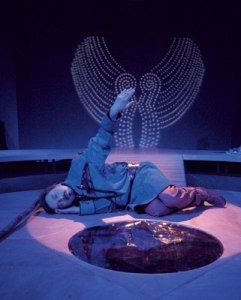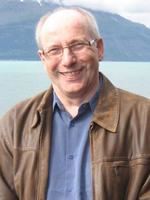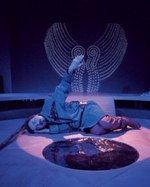 |
| Den rimhårede... |
This view is expressed in several of his poems, and it is also the main message in his play Den Rimhårede og Drømmeseeren (The hoary-haired and the dream seer). The play – for that matter, the only dramatic work from Nils-Aslak Valkeapää’s hand – is in many ways his testament to the readers. The hoary-haired one is the wise old man who wishes to transfer the knowledge to his young pupil. The main point in this knowledge is that man must never forget that he is just a part of nature. Everything is transitory, everything changes, but if we stop taking care of our Mother Earth, then we are all in danger. Indigenous people have gotten the special task of reminding the world of this obligation. Therefore, we must never fall asleep on our mission, but on the contrary carry out our duty. As thanks Life will value us and we can enjoy our existence as children of Mother Earth.
The Earth, My Mother is thus also the title of one of Nils-Aslak’s three most important books. It is in many ways his gift to the world’s indigenous people both in word and in illlustrations. It is written in Sami – our indigenous language in the north – but its message is for all indigenous people in the world. One can be taken aback somewhat as to why Nils-Aslak chose to write one of his most international books in Sami, the choice of language undeniably limits the readership significantly. For him though it was vitally necessary to write the book in Sami, because it is precisely through the mother tongue that one expresses ones feelings best, and with the book The Earth, My Mother Nils-Aslak wanted a chance to speak to the indigenous people. Therefore it was very important to have the book translated into English and Spanish as soon as possible, but also into other indigenous languages because the message is intended for others than just his own people, the Sami. Nils-Aslak’s choice shows what faith he had in language, not least his own mother tongue, when he chose to write a globally intended book in Sami. The Earth, My Mother is, similar to all Nils-Aslak’s books, very carefully thought out in the way the different art forms function together, the way they result in a larger entity, where the sum of words, images and associations is intended to get us to see the interrelationships we all live in, as individuals and as people, with nature as lifegiving force and prerequisite for all life.
In his time as cultural coordinator for the World Council of Indigenous People it was urgent for Nils-Aslak to contribute to creating arenas for indigenous peoples where they could meet – where music, poetry and art could be expressed, for it is in the art, in the traditions, that philosoply of life and knowledge is found, he thought. Therefore, he invested so much time and resources to accomplish and organize the world’s first indigenous festival Davvi Šuvva in 1979. Besides, one often hears reference to the story of how Nils-Aslak used yoik as proof that he and the Sami delegation really were indigenous people during the first meeting of the World Council of Indigenous Peoples in Port Albernie, Canada in 1974. Several of the indigenous representatives from other places in the world were, you see, skeptical of the Sami because of their light skin color, but when Valkeapää performed a yoik for the assembly, the skepticism was as if blown away and the Sami were accepted on a level with the others.
In the same way that one has to work energetically to acquire formal knowledge, one has to invest time in learning the traditions. Interpreting nature, learning to read it, is a lifelong education, in the same way as becoming a recognized shaman required great sacrifices and an enormous work effort, where not least knowledge of myths and traditions was important. Nils-Aslak’s respect for the myth that describes the Sami as descendants of the Sun, emerges most clearly in the prize-winning book, Solen, min far (The Sun, My Father), 1991. In his last years Nils-Aslak was often regarded as being a shaman , not because he himself wanted to, but because people ascribed to him characteristics that the traditional shaman had, and also because he more and more withdrew from society. He became like his own sculptor Eaidánas ealli – one who thrives best alone, like the animal that prefers to stay a little apart from the herd. From there he could better observe what was in the process of happening to his people and the culture.
Nils-Aslak wished to conclude his literary life with an essay book. It would contribute to completing the circle. He debuted, you see, with an essayistic pamphlet in 1971. Forty years later Eanni eannážan appeared with his message about the Earth, our mother, and after that he wished to sum up his conception of life and philosophy in the book which would have the same title as the sculpture Eaidánas ealli – which stood, and still stands, placed in the bedroom in the residence Lásságámmi in Skibotn. The sculpture became his alter ego, which he said good night to when he went to bed, and good morning to when he got up – as an eternal conversation with himself for thereby being able to understand others better.
Already as a child Nils-Aslak spoke to the birds, the trees, he listened to Nature, and later as an artist he became one of the strongest mediators of Nature’s message. One must be humble in order to hear and understand, is how he expresses it so precisely in this little poem: ”Kan du høre livets lyder / i bruset fra elven/ i vindens sus/ Det er alt jeg vil si / det er alt.” (”Can you hear life’s sounds / in the rushing of the brook / in the whistling of the wind / That is all I want to say / that is all.”) Nils-Aslak saw the traditional reindeer migration over the snow-covered mountain plateau landscape as a billowing sea – a sea with sounds of bells and snorting reindeer that reminded him of music. He was on the other hand doubtful whether city folk are able to see the beauty in a reindeer herd migrating, whether the distance to Nature in today’s society makes it more difficult to read the reindeer herd as a poem and hear the bell clanging as a symphony.
The ”my home is in my heart” sequence from Vindens veier is perhaps the text excerpt that has reached farthest out into the world of all Sami literature along with Olaus Sirma’s love poems from the 17th century. In this text one finds the classical conflict between a western ownership and profit relationship to nature in contrast to a relationship based more on kinship and equality with our closest surrounding, expressed through the indigenous peoples’ respect and gratitude for nature. The poem is an original indigenous text about love for land and water, and describes the sensitivity over the loss of freedom of action over ones own areas. Its elegiac form makes it recognizable by all indigenous peoples who have suffered loss, but who in spite of it choose to fight on – their own struggle and fig

Om artikkelforfatteren
Harald Gaski (f. 1955) er opprinnelig fra Tana i Finnmark. Gaski er førsteamanuensis i samisk litteratur og kultur ved Fakultet for humaniora, samfunnsvitenskap og lærerutdanning, Universitetet i Tromsø – Norges arktiske universitet. Han har utgitt en rekke bøker og artikler om samisk kultur og litteratur på samisk, norsk og engelsk, samt oversatt samisk skjønnnlitteratur til norsk og engelsk. Han har særlig forsket på multikunsten til Nils-Aslak Valkeapää og jobbet mye med urfolkslitteratur. I den senere tid har han også spesialisert seg innen urfolksmetodologi. Gaski har vært sentral i oppbyggingen av samisk litteratur som akademisk disiplin, både som forsker, veileder og ikke minst som lærebokforfatter.





